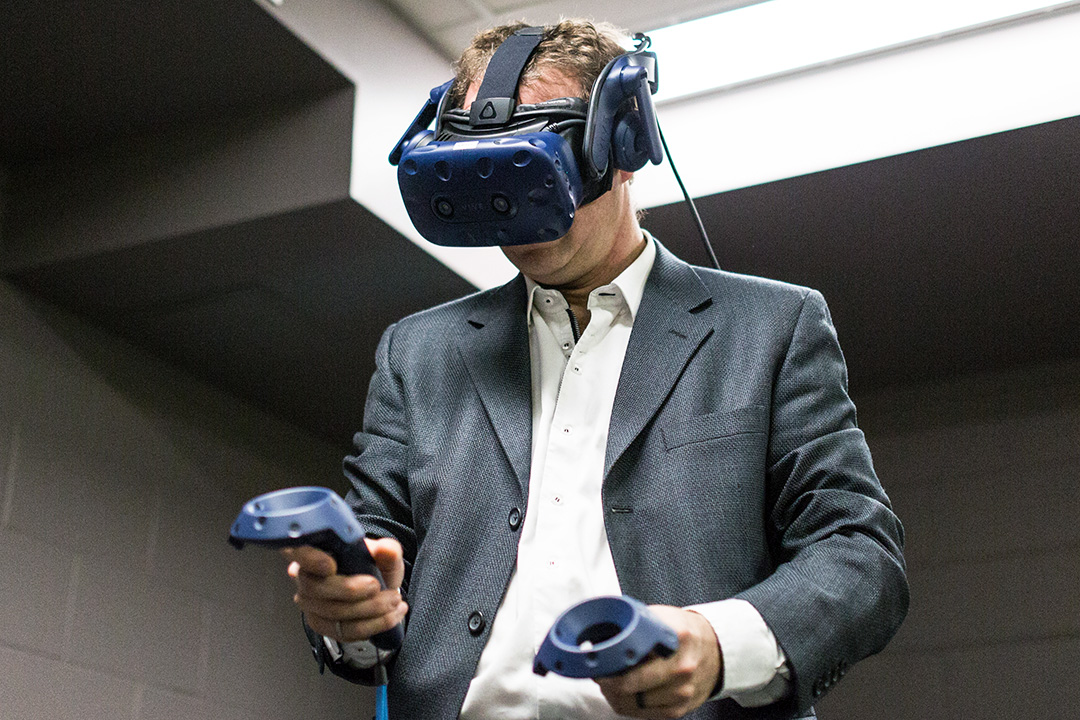
Virtual failures offer real learning in USask engineering lab
A flatbed truck drives onto a newly built truss bridge that spans an imposing gorge with steep, rocky sides.
By Donella HoffmanBut the truck doesn’t get far before disaster strikes. The poorly designed bridge can’t support the weight of the truck and its load. A second after the road surface buckles, both it and the truck are plummeting toward the ground. A huge cloud of black smoke erupts after impact. It’s a true engineering disaster—or it would be if it had happened in real life.
But thankfully, this accident was a virtual one. The bridge that failed was designed in virtual reality (VR) by a first-year engineering student learning the intricacies of truss design. Within a minute, a new, better bridge is constructed and another virtual flatbed is driving across without incident.
During the last school year, students in the University of Saskatchewan College of Engineering did this build/crash/rebuild scenario thousands of times, thanks to new software dubbed Truss VR, developed by the college in partnership with a local tech company, Sprockety, and the Gwenna Moss Centre for Teaching and Learning.
Their work was backed by alumni Ron and Jane Graham, whose donation supported the creation of the software and the Virtual Reality Teaching and Cloud-Based Learning (ViRTCL) Lab in the Engineering Building.
“VR has the potential to be a transformative technology to improve learning,” said Associate Professor Dr. Sean Maw (PhD), the Gerry G. Huff Chair in Innovative Teaching, who is based in the college’s Graham School of Professional Development.
Maw, a professional engineer, spearheaded the project after seeing a presentation about VR by Sprockety at the Gwenna Moss Centre. Ryan Banow, an educational development specialist from the centre, also worked on the project.
Truss VR is designed to help engineering students learn about trusses, a common topic in their first-year statics course. Last year, it was used as a lab and a pilot study was done to evaluate its effectiveness as a learning tool. Truss problems are not difficult to do on paper, but students can spend up to half an hour solving one loading scenario for a simple truss.
“As a result, few students develop a ‘feel’ for a given type of truss and how it behaves under a variety of loading conditions,” Maw wrote in the paper he co-authored with Banow, which was presented at this summer’s Canadian Engineering Education Association conference.
Truss VR has three modules, described this way in the paper:
- The first module rewards students for looking at, and testing, a variety of truss designs
- The second module tests their ability to determine external loads that produce given internal forces and vice versa
- The third allows students to build truss bridges and test them
When students apply virtual loads to the trusses, they are shown via colour coding which parts of the truss are in tension, or compression, or are experiencing no force.
“By hiding the mathematics, the students can focus on what loads do to the truss and how the truss reacts,” the paper states.
Before VR was available, students used specialized construction kits to build models of trusses and bridges in a lab class.
Engineering master’s student Shaunti Bergen learned about trusses the traditional way, but after she tried out Truss VR, she was sold on its educational benefits and the fun factor.
“It shows us what we visualize, but can’t actually test,” she said. “With VR, students can confidently use what they’ve learned without wrecking a whole bunch of stuff.”
After evaluating the pilot project, Maw and Banow found significant evidence showing higher rates of recall and recognition for truss types after having gone through Truss VR. That evidence was inconclusive as to whether students who used Truss VR had higher skill with trusses, although they did have the highest scores on nine of 15 measures testing their overall knowledge and retention.
“As such, one could cautiously conclude that Truss VR had positive effects on learning,” they wrote.
Maw and Banow are continuing to analyze data and plan to refine their methods when they begin another data collection this fall.

